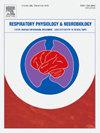Bulk and regional diaphragm blood flow during chemical hyperpnea in pulmonary hypertensive rats
IF 1.6
4区 医学
Q3 PHYSIOLOGY
引用次数: 0
Abstract
Pulmonary hypertension (PH) is a disease characterized by increased pulmonary arterial pressures, impaired gas exchange, dyspnea, and diaphragmatic dysfunction. Specifically, in PH, the diaphragm displays impaired contractility, vascular dysfunction, and blood flow redistribution toward less mechanically advantageous regions such as the ventral costal and crural diaphragm at rest and during submaximal exercise. While diaphragm blood flow is not a limitation to maximal exercise in health, whether it limits diaphragm function in PH is unknown. We hypothesized that, during chemically induced hyperpnea: 1) diaphragm blood flow will be lower in rats with PH compared with healthy controls due to vasodilatory impairments in the diaphragm vasculature, and 2) in PH, blood flow will be redistributed toward less mechanically advantageous regions of the diaphragm. Female Sprague-Dawley rats were randomized into healthy (n = 12) or monocrotaline-induced PH (n = 12) groups. Fluorescent microspheres were used to determine bulk and regional diaphragm blood flow at rest and during hypoxic-hypercapnic gas inhalation (10 % O2-8 % CO2). During chemically induced hyperpnea, diaphragm blood flow was higher in PH compared with healthy controls (483 ± 102 vs. 298 ± 119 ml/min/100 g; P < 0.001), and the ventral costal and crural regions of the diaphragm supported greater perfusion in PH. These results are consistent with previous findings at rest and during submaximal exercise in PH, which may help explain diaphragmatic weakness and dyspnea across a range of ventilatory demands in PH.
肺动脉高压大鼠化学呼吸过度时的大容量和区域膈血流量。
肺动脉高压(PH)是一种以肺动脉压升高、气体交换受损、呼吸困难和膈功能障碍为特征的疾病。具体来说,在PH下,膈肌在休息和次极限运动时表现出收缩性受损,血管功能障碍,血流重新流向机械上不太有利的区域,如腹侧肋膈和脚膈。虽然膈血流量并不是健康状态下最大运动的限制,但它是否限制了PH值下膈血的功能尚不清楚。我们假设,在化学诱导的呼吸急促过程中:1)与健康对照相比,PH大鼠的膈血流量会减少,因为膈血管的血管扩张功能受损;2)PH大鼠的血流量会重新分布到机械上不太有利的膈区域。雌性Sprague-Dawley大鼠随机分为健康组(n=12)和单藜碱诱导PH组(n=12)。荧光微球用于测定静息和低氧-高碳酸气体吸入(10% O2-8% CO2)时的整体和区域隔膜血流量。化学诱导呼吸急促时,膈血流量PH值高于健康对照组(483±102 vs 298±119ml/min/100g;P
本文章由计算机程序翻译,如有差异,请以英文原文为准。
求助全文
约1分钟内获得全文
求助全文
来源期刊
CiteScore
4.80
自引率
8.70%
发文量
104
审稿时长
54 days
期刊介绍:
Respiratory Physiology & Neurobiology (RESPNB) publishes original articles and invited reviews concerning physiology and pathophysiology of respiration in its broadest sense.
Although a special focus is on topics in neurobiology, high quality papers in respiratory molecular and cellular biology are also welcome, as are high-quality papers in traditional areas, such as:
-Mechanics of breathing-
Gas exchange and acid-base balance-
Respiration at rest and exercise-
Respiration in unusual conditions, like high or low pressure or changes of temperature, low ambient oxygen-
Embryonic and adult respiration-
Comparative respiratory physiology.
Papers on clinical aspects, original methods, as well as theoretical papers are also considered as long as they foster the understanding of respiratory physiology and pathophysiology.

 求助内容:
求助内容: 应助结果提醒方式:
应助结果提醒方式:


